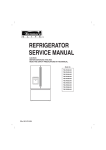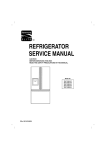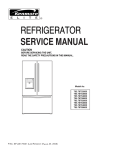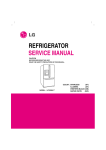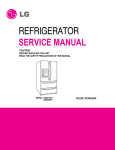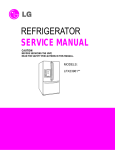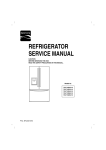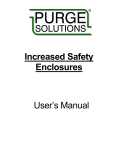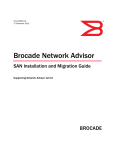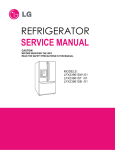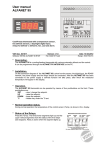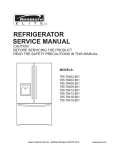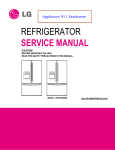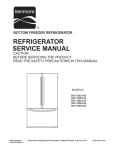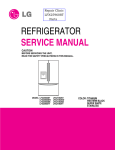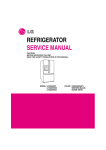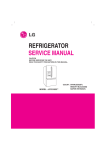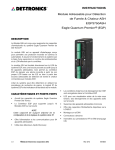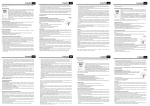Download REFRIGERATOR SERVICE MANUAL
Transcript
REFRIGERATOR SERVICE MANUAL CAUTION BEFORE SERVICING THE UNIT, READ THE SAFETY PRECAUTIONS IN THIS MANUAL. Model #s: 795.71082.01* 795.71083.01* 795.71089.01* P/No. MFL48179017 (Last Revision: January. 18. 2010) CONTENTS SAFETY PRECAUTIONS ....................................................................................................................................................... 2 1. SPECIFICATIONS ........................................................................................................................................................... 3-4 2. PARTS IDENTIFICATION .................................................................................................................................................. 5 3. DISASSEMBLY ............................................................................................................................................................. 6-14 REMOVING AND REPLACING REFRIGERATOR DOORS .............................................................................................. 6 DOOR ................................................................................................................................................................................. 7 DOOR ALIGNMENT ........................................................................................................................................................... 8 FAN AND FAN MOTOR(Evaporator) .................................................................................................................................. 8 DEFROST CONTROL ASSEMBLY .................................................................................................................................... 9 LAMP .................................................................................................................................................................................. 9 MULTI DUCT .................................................................................................................................................................... 10 MAIN PWB ........................................................................................................................................................................ 10 DISPENSER ..................................................................................................................................................................... 10 DISPLAY PWB REPLACEMENT ...................................................................................................................................... 10 FUNNEL REPLACEMENT ................................................................................................................................................ 10 SUB PWB FOR DISPENSER ........................................................................................................................................... 11 DUCT DOOR REPLACEMENT ........................................................................................................................................ 11 ICE CORNER DOOR REPLACEMENT ............................................................................................................................ 11 ICEMAKER ASSEMBLY ................................................................................................................................................... 11 AUGER MOTOR COVER ................................................................................................................................................. 12 HOW TO REMOVE A DOOR ICE BIN .............................................................................................................................. 13 HOW TO INSERT A DOOR ICE BIN ................................................................................................................................ 13 HOW TO REMOVE AND REINSTALL THE PULLOUT DRAWER .............................................................................. 14-15 WATER VALVE DISASSEMBLY METHOD ...................................................................................................................... 16 FAN AND FAN MOTOR DISASSEMBLY METHOD ......................................................................................................... 16 PULL OUT DRAWER ........................................................................................................................................................ 17 4. ADJUSTMENT ............................................................................................................................................................ 18-19 COMPRESSOR ................................................................................................................................................................ 18 PTC-STARTER ................................................................................................................................................................. 18 OLP(OVERLOAD PROTECTOR) ..................................................................................................................................... 19 TO REMOVE THE COVER PTC ...................................................................................................................................... 19 5. CIRCUIT DIAGRAM ......................................................................................................................................................... 20 6. TROUBLESHOOTING ................................................................................................................................................ 21-25 7. OPERATION PRINCIPLE AND REPAIR METHOD OF ICEMAKER ......................................................................... 26-28 8. DESCRIPTION OF FUNCTION & CIRCUIT OF MICOM ............................................................................................ 29-45 SAFETY PRECAUTIONS Please read the following instructions before servicing your refrigerator. 1. Unplug the power before handling any elctrical componets. 2. Check the rated current, voltage, and capacity. 3. Take caution not to get water near any electrical components. 4. Use exact replacement parts. 5. Remove any objects from the top prior to tilting the product. -2- 1. SPECIFICATIONS 1-1 DISCONNECT POWER CORD BEFORE SERVICING IMPORTANT - RECONNECT ALL GROUNDING DEVICES 1-7 REPLACEMENT PARTS All parts of this appliance capable of conducting electrical current are grounded. If grounding wires, screws, straps, clips, nuts or washers used to complete a path to ground are removed for service, they must be returned to their original position and properly fastened. Relay ............................................................ EBG60658602 Overload ........................................................ 6750C-0004U Defrost Thermostat ....................................... 6615JB2005H Defrost Heater ............................................... 5300JK1005D Evaporator Fan Motor ................................... 4681JB1027C (4681JK1004E) Capacitor (Running) ..................................... 0CZZJB2014K (0CZZJB2012K) Compressor (Hi-Side) ................................... TCA34632301 Evaporator (Lo-Side) ..................................... 5421JJ1003B Condenser ................................................... ACG72915201 Dryer ............................................................. 5851JA2007E Condenser Fan Motor ................................... 4681JB1029D Temperature Control ............................ ACQ36820506(SW) ACQ36820507(WB) ACQ36820508(BI) ACQ36820509(STS) ACQ36820510(BS) Main Control ................................................. EBR41956436 Ice Fan Motor ................................................ 4681JB1027E 21 cuft 795.71082.01* 795.71083.01* 795.71089.01* 1-2 IMPORTANT NOTICE This information is intended for use by individuals possessing adequate backgrounds of electrical, electronic and mechanical experience. Any attempt to repair a major appliance may result in personal injury and property damage. The manufacturer or seller cannot be responsible for the interpretation of this information, nor can it assume any liability in connection with its use. 1-3 ELECTRICAL SPECIFICATIONS Temperature Control (Freezer Compartment) .. -6°F to +8°F Defrost Control .....Total Comp Running Time: 7 hrs~50 hrs Defrost Thermostat ...................................................... 46°F Electrical Rating : 115VAC, 60Hz ................................ 7.2 A Maximum Current Leakage ...................................... 0.5 mA Maximum Ground Path Resistance ................... 0.14 Ohms Energy Consumption ....................... 21 cu.ft. 527 (E/STAR) .......................................................... 25 cu.ft. 547 (E/STAR) 1-4 NO LOAD PERFORMANCE CONTROL POSITION : MID/MID And Ambient of : ................ 70°F ................................. 90°F Fresh Food, °F .................. 33°F to 41°F ........ 33°F to 41°F Frozen Food, °F ................ -4°F to +4°F ......... -4°F to +4°F Percent Running Time ...... 35%-45% ................. 50°F-70°F 1-5 REFRIGERATION SYSTEM Minimum Compressor Capacity Vacuum ................ 21 MIN. Minimum Equalized Pressure @ 70°F ............................................................ 49 PSIG @ 90°F ............................................................ 56 PSIG Refrigerant R134a ................................................... 5.11 oz. Compressor ....................................................... 956 BTU/hr 1-6 INSTALLATION Clearance must be provided at top, sides and rear of the refrigerator for air circulation. AT REAR ....................................................................... 1 in 1-8 AIR FLOW / CIRCULATION D’AIR -3- Description 795.71082.01* Depth w/ Handles A 30 in. Depth w/ o Handles B 27 1/2 in. Depth w/ o Door C 23 5/8 in. Depth (Total with Door Open) D 42 1/4 in. Height to Top of Case E 68 3/8 in. Height to Top of Door Hinge F 69 3/4 in. Width G 35 3/4 in. Width (door open 90 deg. w/o handle) H 39 1/4 in. Width (door open 90 deg. w/ handle) I 44 1/4 in. -4- 2. PARTS IDENTIFICATION Use this page to become more familiar with the parts and features. Page references are included for your convenience. NOTE : This guide covers several different models. The refrigerator you have purchased may have some or all of the items listed below. The locations of the features shown below may not match your model. A Refrigerator Light K Pull out Drawer B Filter (Inside) L Durabase C Modular Door Bins M Divider D Fixed door bin N Tilt-Out Door Basket E Fixed door bin O Dairy Bin F Refrigerator Shelves P Water Tank Cover G Ice Room (Ice Maker and Ice Bucket) H Humidity Controlled Crisper I Glide‘N’Serve J Extra Ice Bin -5- 3. DISASSEMBLY 3-1 REMOVING AND REPLACING REFRIGERATOR DOORS To remove the left refrigerator door: Pull the water tube out of the fitting while pressing the release ring on the fitting. When you pull out the tube, first you have to push the collet by opposite direction of arrow in the upper picture and tube pull out by direction of arrow. CAUTION : Before you begin, remove food and bins from the doors. To remove the right refrigerator door: Open the door. Remove the top hinge cover screw (1). Lift up the cover (2). Remove the cover. Disconnect the wire harness (3). Remove the grounding screw (4). Rotate the hinge lever (5) clockwise and remove. Lift the top hinge (6) free of the hinge lever latch (7). IMPORTANT : When lifting the hinge free of the latch, be careful that the door does not fall forward. WARNING Explosion Hazard Disconnect electrical supply to the refrigerator before installing. Failure to do so could result in death or serious injury. Do not put hands or feet or other objects into the air vents, base grille, or bottom of the refrigerator. You may be injured or receive an electrical shock. Be careful when you work with the hinge, base grille, and stopper. You may be injured. Open the door. Remove the top hinge cover screw (1). Use a flat-head screwdriver to pry back the hooks (not shown) on the front underside of the cover (2). Lift up the cover. Remove the cover. Pull out the tube (3). Disconnect all the wire harnesses (4). Remove the grounding screw(5) Rotate hinge lever (6) counterclockwise and remove. Lift the top hinge (7) free of the hinge lever latch (8). IMPORTANT : When lifting the hinge free of the latch, be careful that the door does not fall forward. Lift the door from the middle hinge pin and remove the door. Place the door, inside facing up, on a nonscratching surface. -6- 3-2 DOOR Door Gasket Removal 1. Remove door frame cover Starting at top of cover and working down, snap cover out and away from door. Door Gasket Replacement 1. Insert gasket bracket clips 1) Insert gasket bracket edge beneath door frame edge. 2) Turn upper gasket bracket spring so that the spring ends are in the door channel. 3) Push in clip until you hear it snap securely into place. Gasket Bracket Clip Frame Cover Handle Spring Door Frame Correct Incorrect Figure 1 Figure 4 2. Remove gasket bracket clips There are two clips on each door. Start bracket removal near one of the middle clips. 1)Pull gasket back to expose gasket bracket clip and door frame. 2)Insert a flat tip screwdriver into seam between gasket bracket and door frame and pry back until clips snap out. 3)Continue prying back along seam until all clips snap out. 4) Push in remaining clip until you hear it snap securely into place. Note : Make sure that no part of gasket bracket edge protrudes from beneath door frame edge. Door Frame 2. Insert gasket into channel 1) Snap gasket assembly into the door bracket. <Inserting the Gasket Assembly into the Bracket Door> Gasket Bracket Clip Flat Tip Screwdriver Correct Gasket Bracket Figure 2 3. Remove gasket Pull gasket free from gasket channel on the three remaining sides of door. Incorrect Figure 3 -7- Figure 5 2) Press gasket into channels on the three remaining sides of door. 3-3 DOOR ALIGNMENT If the space between your doors is uneven, follow the instructions below to align the doors : 1. With one hand, lift up the door you want to raise at middle hinge. 2. With other hand, use pliers to insert snap ring as shown. 3. Insert additional snap rings until the doors are aligned. (Three snap rings are provided with unit.) Figure 6 3. Replace door frame cover Starting at top of cover and working down, snap cover back into door. Figure 10 Figure 7 3-4 FAN AND FAN MOTOR(EVAPORATOR) 1. Remove the freezer shelf. (If your refrigerator has an icemaker, remove the icemaker first) 2. Remove the plastic guide for slides on left side by unscrewing phillips head screws. 3. Remove the grille by removing one screw and pulling the grille forward. 4. Remove the Fan Motor assembly by loosening 2 screws and disassembling the shroud. 5. Pull out the fan and separate the Fan Motor and Bracket. FAN MOTOR FAN BRACKET MOTOR GRILLE -8- Figure 11 * Ice Fan Scroll Assembly Replacement 3-6 LAMP Unplug Refrigerator, or disconnect power at the circuit breaker. If necessary, remove top shelf or shelves. 1) Remove the plastic guide for slides on left side by unscrewing phillips head screws. 2) Pull the grille forward as shown in the second picture. 3) Disconnect wire harness of the grille. 4) Remove the scroll assembly by loosening all screws. 3-6-1 Refrigerator Compartment Lamp 1) Release 2 screws. 2) Hold both ends with your both hands and pull it downward to remove it. 3) Use a flat tool as shown below to remove the cover lamp. (1) (2) Figure 12 4) As shown below, use a flat tool to remove the cover lamp. (3) (4) 3-5 DEFROST CONTROL ASSEMBLY Defrost Control assembly consists of Defrost Sensor and FUSE-M. The Defrost Sensor works to defrost automatically. It is attached to the metal side of the Evaporator and senses its temperature. At 46°F (8°C), it turns the Defrost Heater off. Fuse-M is a safety device for preventing over-heating of the Heater when defrosting. 1. Pull out the grille assembly. (Figure 10) 2. Separate the connector with the Defrost Control assembly and replace the Defrost Control assembly after cutting the Tie Wrap. (Figure 11) GRILLE ASSEMBLY Figure 13 DEFROST-CONTROL ASSEMBLY Cover, Lamp LED, Assembly Case Lamp Figure 14 3-6-2 Freezer Compartment Lamp 1. Unplug refrigerator power cord form outlet. 2. Remove screw with direver. 3. Grasp the cover Lamp, pull the cover downward. Figure 10 Figure 11 Figure 15 -9- 2) Hold the left and right side of the “Cover Assembly, dispenser” as shown in the picture, and pull and remove it. The cover dispenser is attached with a hook. 3-7 MULTI DUCT 1. Remove the upper and lower Caps by using a flat screwdriver, and remove 2 screws. (Figure 17) 2. Disconnect the lead wire on the bottom position. CAUTION : When replacing the dispenser cover in the reverse order of removal, be careful that the lead wire does not come out and the water tube is not pinched by the dispenser cover, as shown in the picture below. Figure 17 3-8 MAIN PWB 1) Loosen the 4 screws on the PWB cover. 3-10 DISPLAY PWB REPLACEMENT 1) Pull up and out on the dispenser cover to remove. 2) Remove the PWB cover 2) Follow the steps in the pictures 3) Disconnect wire harness and replace the main PWB in the reverse order of removal. 3-11 FUNNEL REPLACEMENT 3-9 DISPENSER 1) Disconnect funnel and button assembly by pulling down and forward. 1) Pull up and out on the dispenser cover to remove. 2) Disconnect the wire harness. 3) Replace in reverse order. - 10 - 3-12 SUB PWB FOR WORKING DISPENSER 3-14 ICE CORNER DOOR REPLACEMENT 1) Loosen the screw on the sub PWB. 1) Loosen the front screw as shown in the picture. 2) Lift up the hinge with one hand. 3) Pull out the Ice Corner Door with the other hand. 2) Pull the sub PWB down. 3) Disconnect the wire harness and replace the sub PWB in the reverse order of removal. 3-15 ICEMAKER ASSEMBLY 1) Loosen two screws as shown in the first picture. 3-13 DUCT DOOR REPLACEMENT 1) 2) 3) 4) Pull up and out on the dispenser cover to remove. Disconnect the wire harness. Remove the funnel Replace in reverse order. 2) Disconnect the wire harness & ground screw replace theIcemaker assembly in the reverse order of removal. 3) It separates a ground connection screw. - 11 - 3-16 AUGER MOTOR COVER 1) After removing the icemaker remove the (5) stainless screws holding the auger motor cover, shown in the picutres below. 2) Grip the bottom of motor cover assembly and pull out it. 3) Disconnect wire harness of motor cover assembly. There is a auger motor on the back, as shown in the picture. Auger Motor Icemaker Power & Full detection Signal - 12 - 3-17 HOW TO REMOVE A DOOR ICE BIN 3-18 HOW TO INSERT A DOOR ICE BIN 1) Grip the handles, as shown in the picture. 1) Insert the Ice Bin, slightly tilting it to avoid touching the Icemaker. (especially, ice maker lever) 2) Lift the lower part slightly. Insert the ice bucket carefully avoid contacing the automatic shut off arm. 3) Take the Ice Bin out slowly. - 13 - 3-19 HOW TO REMOVE AND REINSTALL THE PULLOUT DRAWER 3-19-1 Follow Steps to Remove Step 1) Open the freezer door. Step 2) Remove the lower basket. Step 3) Remove the two screws from the guide rails (one from each side). Step 4) Lift the freezer door up to unhook it from the rail support and remove. Pull both rails to full extension. Step 5) First: Remove the gear from the left side first by releasing the tab behind the gear, place a screwdriver between the gear and the tab and pull up on the gear. Second: Remove the center rail. Third: Remove the gear from the right side by following the same steps for the left side. NOTE : THIS TAB MUST BE PUSHED IN TO RELEASE THE GEAR. - 14 - 3-19-2 Follow Steps to Reinstall Step 1) Reinstall the right side gear into the clip. Step 2) Insert the rail into the right side gear. Gears do not need to be perpendicular to each other. Step 3) Insert the rail into the left side gear, and insert the gear into the clip. Step 4) The rail system will align itself by pushing the rails all the way into the freezer section. Pull the rails back out to full extension. Step 5) Reinstall the freezer door by inserting the rail tabs into the guide rail. Step 6) Reinstall the two screws into the guide rails (one from each side). Step 7) Reinstall the lower basket, and close the freezer door. - 15 - 3-20 WATER VALVE DISASSEMBLY METHOD 3-21 FAN AND FAN MOTOR DISASSEMBLY METHOD 1) Turn off the water. Then separate the water line from the valve. 1) Using a short screwdriver, loosen one SCREW in DRAIN PIPE ASSEMBLY and one connected to the MOTOR COVER. MOTOR COVER 2) Separate the Mechanical Cover and Valve Screw. 2) Pull and separate the FAN ASSEMBLY and MOTOR turning counterclockwise based on the MOTOR SHAFT. Mechanical Cover FAN ASSEMBLY MOTOR 3) Separate the housing and pull out the valve. The assembly is in the reverse order of the disassembly and take special care for the following details. 1. Be careful not to bend the tube during assembly. 2. Press the WATER DISPENSER button until water pours out and check for leakage in the CONNECTOR TUBE (It differs by the water pressure but usually takes about 2 minutes until water pours out.) Housing 4) Lay a dry towel on the floor and get ready to spill water from the water filter. Pull out the Cilp. Then press te collet to separate the tube from the connector and pour out the water until emptied. Collet Tube Insert Line Clip - 16 - 3-22 PULL OUT DRAWER To separate the drawer, push the front left and right hooks in direction to pull up and remove. Then gently lift the gear part of rear left and right side of the drawer and pull it out in direction. To install, reposition the gear part of rear left and right side of the drawer after pulling out both rails as much as possible, and gently push down both left and right side while checking the hook on the front part. - 17 - 4. ADJUSTMENT 4-2-3 PTC-Applied Circuit Diagram 4-1 COMPRESSOR Starting Method for the Motor 4-1-1 Role The compressor intakes low temperature and low pressure gas from the evaporator of the refrigerator and compresses this gas to high-temperature and high-pressure gas. It then delivers the gas to the condenser. 4-1-2 Composition The compressor includes overload protection. The PTC starter and OLP (overload protector) are attached to the outside of the compressor. Since the compressor is manufactured to tolerances of 1 micron and is hermetically sealed in a dust and moisture-free environment, use extreme caution when performing repairs. 4-1-3 Note for Usage (1) Be careful not to allow over-voltage and over-current. (2) If compressor is dropped or handled carelessly, poor operation and noise may result. (3) Use proper electric components appropriate to the Particular Compressor in your product. (4) Keep Compressor dry. If the Compressor gets wet (in the rain or a damp environment) and rust forms in the pin of the Hermetic Terminal, poor operation and contact may result. (5) When replacing the Compressor, be careful that dust, humidity, and soldering flux don’t contaminate the inside of the compressor. Dust, humidity, and solder flux contaminate the cylinder and may cause noise, improper operation or even cause it to lock up. 4-2 PTC-STARTER 4-2-1 Composition of PTC-Starter (1) PTC (Positive Temperature Coefficient) is a no-contact semiconductor starting device which uses ceramic material consisting of BaTiO3. (2) The higher the temperature is, the higher the resistance value. These features are used as a starting device for the Motor. 4-2-2 Role of PTC-Starter (1) The PTC is attached to the Sealed Compressor and is used for starting the Compressor Motor. (2) The compressor is a single-phase induction motor. The starting operation, the PTC allows current flow to both the start winding and main winding. 4-2-4 Motor Restarting and PTC Cooling (1) It requires approximately 5 minutes for the pressure to equalize before the compressor can restart. (2) The PTC device generates heat during operation. Therefore, it must be allowed to cool before the compressor can restart. 4-2-5 Relation of PTC-Starter and OLP (1) If the compressor attempts to restart before the PTC device is cooled, the PTC device will allow current to flow only to the main winding. (2) The OLP will open because of the over current condition. This same process will continue (3 to 5 times) when the compressor attempts to restart until the PTC device has cooled. The correct OLP must be properly attached to prevent damage to the compressor. Parts may appear physically identical but could have different electrical ratings. Replace parts by part number and model number. Use only approved substitute parts. 4-2-6 Note for Using the PTC-Starter (1) Be careful not to allow over-voltage and over-current. (2) Do not drop or handle carelessly. (3) Keep away from any liquid. If liquid such as oil or water enters the PTC, PTC materials may fail due to breakdown of their insulating capabilities. (4) If the exterior of the PTC is damaged, the resistance value may be altered. This can cause damage to the compressor and result in a no-start or hard-to-start condition. (5) Always use the PTC designed for the compressor and make sure it is properly attached to the compressor. Parts may appear physically identical but could have different electrical ratings. Replace parts by part number and model number. Use only approved substitute parts. - 18 - 4-3 OLP (OVERLOAD PROTECTOR) 4-4 TO REMOVE THE COVER PTC 4-5-1 Definition of OLP (1) OLP (OVERLOAD PROTECTOR) is attached to the Compressor and protects the Motor by opening the circuit to the Motor if the temperature rises and activating the bimetal spring in the OLP. (2) When high current flows to the Compressor motor, the Bimetal works by heating the heater inside the OLP, and the OLP protects the Motor by cutting off the current flowing to the Compressor Motor. 4-5-2 Role of the OLP (1) The OLP is attached to the Sealed Compressor used for the Refrigerator. It prevents the Motor Coil from being started in the Compressor. (2) For normal operation of the OLP, do not turn the Adjust Screw of the OLP in any way. (1) Remove the Cover Back M/C. (2) Disconnect two housing upper side of comp connected in. (3) Loosen two screws on comp base. (4) Use a L-shaped flap tool to pry off the cover. (5) Assembly in reverse order of disassembly. Figure 19 - 19 - 5. CIRCUIT DIAGRAM - 20 - 6. TROUBLESHOOTING 6-1 COMPRESSOR AND ELECTRIC COMPONENTS Power Source. YES Remove PTC-Starter from Compressor and measure voltage between Terminal C of Compressor and Terminal 5 or 6 of PTC. (Rated Voltage ±10%)? No Voltage. OLP disconnected? YES Replace OLP. NO # Check connection condition. Reconnect. Applied voltage isn't in acceptable range. (115V ±10%) Advise customer that power supply needs to be checked by an electrician. # The range of resistance is between 1~50 (ok) Check resistance of Motor Compressor. Check resistance between M-C, S-C and M-S in Motor Compressor. ! Check resistance of PTC-Starter. Check resistance of two terminals in PTC-Starter. Reference Page12. " Check OLP. Check resistance of two terminals in OLP. Reference Page12. # Check starting state. Check the power supply under load. (Compressor attempting to re-start after being off for 5 minutes). Supply voltage rating with ±10%. Open or short Replace Compressor. YES ! Did compressor start? " YES NO NO - 21 - ! # Compressor is OK Replace the compressor 6-2 OTHER ELECTRICAL COMPONENTS Not cooling at all Compressor doesn't run. Check for open short or incorrect resistance readings in the following components Cause a. Starting devices Short, open, or broken. b. OLP Poor contact or shorted. c. Compressor coil Coil open or shorted. d. Wiring harness Poor contact or shorted. Replace indicated component. Poor cooling performance Compressor runs poorly. Check starting voltage. Low voltage. Advise customer that the Power supply needs to be checked by an electrician. Check voltage at starting devices. Poor or broken or open contact. Replace indicated component. Check current flowing in sub-coil of Compressor. Fan motor doesn't run. Shorted. Check rating of OLP. Lack of capacity. Check wiring circuit. Wire is open or shorted. Replace indicated component. Coil is shorted or open. Check Fan Motor. Heavy frost buildup on EVAPORATOR. Check current flow in the following components : Sensor Fuse-M Check current flow in the Defrost Heater. - 22 - Open. Replace indicated component. Open. Replace Defrost Heater. 6-3 SERVICE DIAGNOSIS CHART COMPLAINT POINTS TO BE CHECKED Is the power cord unplugged from the outlet? Check if the power switch is set to OFF. Check if the fuse of the power switch is shorted. Measure the voltage of the power outlet. REMEDY No Cooling. • • • • Cools poorly. • Check if the unit is placed too close to the wall. • Check if the unit is placed too close to the stove, gas cooker, or in direct sunlight. • Is the ambient temperature too high or the room door closed? • Check if food put in the refrigerator is hot. • Did you open the door of the unit too often or check if the door is sealed properly? • Check if the Control is set to Warm position. • Place the unit about 4 inches (10 cm) from the wall. • Place the unit away from these heat sources. Food in the Refrigerator is frozen. • Is food placed in the cooling air outlet? • Place foods in the high-temperature section. (front part) • Set the control to Recommended position. • Set the control to Warm position. Condensation or ice forms inside the unit. • Is liquid food sealed? • Check if food put in the refrigerator is hot. • Did you open the door of the unit too often or check if the door is sealed properly? • Seal liquid foods with wrap. • Put in foods after they have cooled down. • Don't open the door too often and close it firmly. Condensation forms in the Exterior Case. • Check if the ambient temperature and humidity of the surrounding air are high. • Is there a gap in the door gasket? • Wipe moisture with a dry cloth. It will disappear in low temperature and humidity. • Fill up the gap. There is abnormal noise. • Is the unit positioned in a firm and even place? • Adjust the Leveling Screw, and position the refrigerator in a firm place. • Remove the objects. • Check if the control is set to colder position. • Is the ambient temperature below 41°F(5°C)? • Are any unnecessary objects placed in the back side of the unit? • Check if the Drip Tray is not firmly fixed. • Check if the cover of the compressor enclosure in the lower front side is taken out. Door does not close well. • Check if the door gasket is dirty with an item like juice. • Is the refrigerator level? • Is there too much food in the refrigerator? Ice and foods smell unpleasant. • Check if the inside of the unit is dirty. • Are foods with a strong odor unwrapped? • The unit smells of plastic. • • • • Plug into the outlet. Set the switch to ON. Replace the fuse. If the voltage is low, correct the wiring. • Lower the ambient temperature. • Put in foods after they have cooled down. • Don't open the door too often and close it firmly. • Set the control to Recommended position. • Fix the Drip Tray firmly in the original position. • Place the cover in its original position. • Clean the door gasket. • Position in a firm place and level the Leveling Screw. • Make sure food stored in shelves does not prevent the door from closing. • Clean the inside of the unit. • Wrap foods that have a strong odor. • New products smell of plastic, but this will go away after 1-2 weeks. Other possible problems: Check if frost forms in the freezer. Not defrosting Check Components of the defrosting circuit. Check the refrigeration system. The system is faulty. Perform sealed system repair. Check the Thermistor. The operation of the Thermistor is incorrect. Replace the Thermistor. - 23 - 6-4 REFRIGERATION CYCLE Troubleshooting Chart TEMPERATURE OF THE COMPRESSOR STATE OF THE UNIT STATE OF THE EVAPORATOR PARTIAL LEAKAGE Freezer compartment and Refrigerator don't cool normally. Low flowing sound of Refrigerant is heard and frost forms in inlet only. A little higher than ambient temperature. • Refrigerant level is low due to a leak. • Normal cooling is possible by restoring the normal amount of refrigerant and repairing the leak. COMPLETE LEAKAGE Freezer compartment and Refrigerator don't cool normally. Flowing sound of refrigerant is not heard and frost isn't formed. Equal to ambient temperature. • No discharging of Refrigerant. • Normal cooling is possible by restoring the normal amount of refrigerant and repairing the leak. PARTIAL CLOG Freezer compartment and Refrigerator don't cool normally. Flowing sound of refrigerant is heard and frost forms in inlet only. A little higher than ambient temperature. • Normal discharging of the refrigerant. • The capillary tube is faulty. WHOLE CLOG Freezer compartment and Refrigerator don't cool. Flowing sound of refrigerant is not heard and frost isn't formed. Equal to ambient temperature. • Normal discharging of the Refrigerant. Cooling operation stops periodically. Flowing sound of refrigerant is not heard and frost melts. Lower than ambient • Cooling operation restarts temperature. when heating the inlet of the capillary tube. COMPRESSION Freezer and Refrigerator don't cool. Low flowing sound of refrigerant is heard and frost forms in inlet only. A little higher than ambient temperature. • Low pressure at high side of compressor due to low refrigerant level. NO COMPRESSION No compressing operation. Equal to ambient temperature. • No pressure in the high pressure part of the compressor. CAUSE LEAKAGE CLOGGED BY DUST MOISTURE CLOG DEFECTIVE COMPRESSION Flowing sound of refrigerant is not heard and there is no frost. - 24 - REMARKS 6-4-1 SEALED SYSTEM DIAGNOSIS “Not Cooling” Complaint All components operating, No airflow problems, Not frosted up as a defrost problem problem has been isolated to sealed system area Frost Pattern? Partial None Equalization Test Equalization Test Very Fast Very Slow Very Slow Very Fast Fast Inefficient Compressor Partial Restriction Complete Restriction Condenser Temperature Cap Tube Sound Hotter than Normal Faint Room Temperature None to Weak Air/Low Side Leak Loss of Change Compressor Not Pumping Trace of Oil Yes No Leak Undercharge (The equalization test is trying to restart a compressor using a start kit after it has been operating.) - 25 - 7. OPERATION PRINCIPLE AND REPAIR METHOD OF ICEMAKER 7-1 OPERATION PRINCIPLE 7-1-1 Operation Principle of IceMaker Power On Start Position Icemaking Mode • Adjusts EJECTOR to Start Position with power on. • Waits until water becomes ICE after starting the icemaking operation. Harvest Mode • Runs MOTOR to drop ice from the tray into the ICE BIN. (During harvest mode, check if the ice bin is full) Park Position • Reaches Start Position • Performs Ice Making Mode after supplying water by operating the SOLENOID in ICE VALVE. Fill • To operate LINE and SERVICE, press and hold the Fill Key for 3 seconds. The icemaker will run through 3 stages: Harvest Fill Icemaking. Test Mode 1. Turning the Icemaker stop switch off (O) stops the ice making function. 2. Setting the Icemaker switch to OFF and then turning it back on will reset the icemaker control. EJECTOR Automatic Shut off Arm Cube Size Indicator Light Cube Size Selection Button - 26 - Power Switch 7-2 ICE MAKER FUNCTIONS 7-2-1 Icemaking Mode 1. Icemaking refers to the freezing of supplied water in the ice tray. Complete freezing is assured by measuring the temperature of the Tray with Icemaking SENSOR. 2. Icemaking starts after completion of the water fill operation. 3. The Ice Making function is completed when the sensor reaches 19°F (-7°C), 55 minutes after starting. NOTE : After Icemaker Power is ON, the Icemaker heater will be on for test for 6 sec. 7-2-2 Harvest Mode 1. Harvest (Ice removing) refers to the operation of dropping ices into the ice bin from the tray when icemaking has completed. 2. Harvest mode: (1)The Heater is ON for 30 seconds, then the motor starts. (2)The feeler arm senses the quantity of ice in the ice storage bin while rotating with the EJECTOR. A. Ice storage bin is full : The EJECTOR stops (heater off). B. Ice storage bin is not full : The EJECTOR rotates twice to open for ice. If the EJECTOR does not rotate once within 5 minutes in B mode, separate heater control mode starts operating to prevent the EJECTOR from being constrained. (It is recommended that the user open for ice to return to normal mode.) 7-2-3 Fill/Park Position 1. Once a normal harvest mode has been completed, the water solenoid will be activated. 2. The amount of water is adjusted by pressing the Fill Key repeatedly. This changes the time allowed for fill as illustrated in the table below. Water supply amount TABLE STAGE TIME TO SUPPLY 1 5 sec. 2 5.5 sec. (FIRST STAGE) 3 6 sec. INDICATIONS REMARKS The water amount will vary depending on the water control Switch setting, as well as the water pressure of the connected water line. - 27 - 7-2-5 Function TEST 1. This is a forced operation for TEST, Service, cleaning, etc. It is operated by pressing and holding the Fill Key for 3 seconds. 2. The test works only in the Icemaking Mode. It cannot be entered from the Harvest or Fill mode. 3. Caution! If the test is performed before water in the icemaker is frozen, the ejector will pass through the water. When the Fill mode begins (Stage 4), unless the water supply has been shut off, added water will overflow into the ice bin. If the control doesn’t operate normally in the TEST mode, check and repair as needed. 4. After water is supplied, the normal CYCLE is followed: icemaking Harvest Park Position Fill. 5. Five seconds after Stage 5 is completed, the Ice Maker returns to MICOM control. The time needed to supply water resets to the pre- test setting. Diagnosis TABLE STAGE ITEMS INDICATOR REMARKS 1 HEATER Five seconds after heater starts, a heater will go off if the temperature by sensor is higher than 10°C 2 MOTOR Five seconds after heater starts, you can confirm that a motor is moving. 3 HALL IC I Check if Ice Bin is full or not. If Ice bin is full, the motor and heater are off and on stand by until Ice bin is empty. 4 HALL IC II You can confirm HALL IC detection of start position. 5 VALVE 6 Reset Two seconds after detection of start position, you can confirm that valve is on. Five seconds after fifth stage is completed, The icemaker resets to initial status. Return to Status prior to TEST MODE 7-3 DEFECT DIAGNOSIS FUNCTION 7-3-1 ERROR CODES shown on Ice Maker water supply control panel NO DIVISION INDICATOR CONTENTS 1 Normal Mark time to supply None 2 Icemaking Sensor malfunction Open or short-circuited wire - 28 - REMARKS Display switch operates properly Make sure that the wire on each sensor is connected. 8. DESCRIPTION OF FUNCTION & CIRCUIT OF MICOM 8-1 FUNCTION 8-1-1 Function 1. When the appliance is plugged in, it is set to 37°F for Refrigerator and 0°F for freezer. You can adjust the Refrigerator and the Freezer control temperature by pressing the ADJUST button. 2. When the power is initially applied or restored after a power failure, it is set to Control temperature Previously. 8-1-2 How to Toggle the Display between °F & °C 1. The initial setting is °F and the display temperature mode can be changed from °F to °C or °C to °F by pressing and holding the FRZ TEMP and the REF TEMP keys at the same time for over 5 seconds. 8-1-3 Lock function (dispenser and display button lock) 1. When the refrigerator is first turned on, the buttons are not locked. The display panel shows the padlock unlocked icon. 2. To lock the display, the dispenser, and the control panel, press and hold the LOCK button for 3 seconds. The locked pad lock icon is displayed. 3. The LOCK button is the only control feature that remains active in the locked state. The buzzer sound, other control buttons, and the dispenser are deactivated. 4. To release from the locked state, press and hold the LOCK button again for 3 seconds. Press & Hold Ex) In selecting "LOCK" Press & Hold Ex) In selecting "LOCK" again 8-1-4 Filter condition display function 1. There is a replacement indicator light for the filter cartridge on the dispenser. 2. Water filter needs replacement once six months or of using water filter. 3. Water Filter icon turn on to tell you need to replace the filter soon. 4. After replacing the filter, press and hold the lock button more than 3 seconds. Water Filter icon turn off with reset status. Classification In initial Power On / Filter RESET Replace indicator light on Press & Hold Press & Hold Filter Status Display - 29 - 8-1-5 Ultra Ice selection Please select this function for quick freezing. • Function is repeat Ultra Ice Icon whenever pressing Ultra Ice button. • Ultra Ice function automatically turns off after a fixed time passes. 8-1-6 Dispenser use selection You can select water or ice. Select water, crushed ice, or ice cubes by cycling through the selections when pressing the DISPENSER button, Hold your cup in the dispenser for a few seconds after dispensing ice or water to allow the last pieoes of ice or drops of water to fall into the cup. When after initially establ ishing the water comes out, the water tank inside fills and until at the time of quality the hour is caught. Pressing Switch 8-1-7 DISPENSER LIGHT - Whenever pressed the LIGHT button, DISPLAY is changed as belows. Normal status : When dispenser is operated, DISPENSER LIGHT is ON. AUTO status : Detecting the lighting of room by LIGHT SENSOR, DISPENSER LIGHT is on and off automatically. ON status : DISPENSER LIGHT is on continuously. 8-1-8 CONTROL OF FREEZER FAN MOTOR 1. Freezer fan motor has high and standard speeds. 2. High speed is used at power-up, for Ultra Ice, and when refrigerator is overloaded. Standard speeds is used for general purposes. 3. To improve cooling speed, the RPM of the freezer fan motor change from normal speed to high. 4. High speed (2700RPM) : Initial power on or load corresponding operation, Ultra Ice. Normal speed (2400RPM) : General working conditions. 5. Fan motor stops when refrigerator or freezer door opens. 8-1-9 Cooling Fan Motor 1. The cooling fan is switched ON and OFF in conjunction with the compressor. 2. The cooling fan Motor has high and standard speeds. (When room temper rapture more high then 38 °C speed is high) 3. The Failure sensing method is the same as in the fan motor of the freezing fan motor(refer to failure diagnosis function table for failure display). 8-1-10 Ice Compartment Fan 1. The Icing Fan is controlled by the the sensor on the top of the ice compartment. 2. The Failure sensing method is the same as in the fan motor of the freezer (refer to failure diagnosis function table for failure display) - 30 - 8-1-11 Ultra Ice 1. 2. 3. 4. The purpose of this function is to intensify the cooling speed of freezer and to increase the amount of ice. Whenever selection switch is pressed, selection/release, the LCD will turn ON or OFF. If there is a power outage and the refrigerator is powered on again, Ultra Ice will be canceled. To activate this function, press the Ultra Ice key and the LCD will turn ON. This function will remain activated for 24 hrs. The first three hours the compressor and Freezer Fan will be ON. The next 21 hours the freezer will be controlled at the lowest temperature. After 24 hours or if the Ultra Ice key is pressed again, the freezer will return to its previous temperature. 5. During the first 3 hours: (1)Compressor and freezer fan (HIGH RPM) run continuously. (2)If a defrost cycle begins during the first 90 minutes of Ultra Ice , the Ultra Ice cycle will complete its cycle after defrosting has ended. If the defrost cycle begins when Ultra Ice has run for more than 90 minutes, Ultra Ice will run for two hours after the defrost is completed. (3)If Ultra Ice is pressed during defrost, Ultra Ice LCD is on but this function will start seven minutes after defrost is completed and it shall operate for three hours. (4)If Ultra Ice is selected within seven minutes after compressor has stopped, the compressor (compressor delays seven minutes) shall start after the balance of the delay time. (5)The fan motor in the freezer compartment runs at high speed during Ultra Ice. 6. For the rest of the 21 hours, the freezer will be controlled at the lowest temperature. 8-1-12 Alarm for Open Door 1. This feature sounds a buzzer when the freezer or refrigerator door is not closed within 1 minute after it is opened. 2. One minute after the door is opened, the buzzer sounds three times each for 1/2 seconds. These tones repeat every 30 seconds. 3. The alarm is cancelled when the freezer or the refrigerator is closed while the buzzer sounds. Freezer Door or Refrigerator Door Closed Open Closed Open Closed 3 Times 3 Times 3 Times 3 Times Buzzer Within 1 min. 1 min. 30 sec 30 sec 30 sec 8-1-13 How to set the display mode and cancel It 1. With the refrigerator door open, keep pressing the Refrigerator Temp Button and ULTRA ICE Button more than 5 seconds, then it goes to the display mode with Special Beep Sound. 2. Perform the same way agin to cancel the display mode. 3. All freezing units do not work at the display mode. (Exceptions : Display, Lamp) - 31 - 8-1-14 Defrosting (removing frost) 1. Defrosting starts each time the COMPRESSOR running time Betwee 7~50 hours. 2. For initial power on or for restoring power, defrosting starts when the compressor running time reaches 4 hours. 3. Defrosting stops if the sensor temperature reaches 46.4°F(8°C) or more. If the sensor doesn’t reach 46.4°F(8°C) in 1 hours, the defrost mode is malfunctioning. (Refer to the defect diagnosis function, 8-1-15.) 4. Defrosting won’t function if its sensor is defective (wires are cut or short circuited) 8-1-15 Defect Diagnosis Function 1. 2. 3. 4. Automatic diagnosis makes servicing the refrigerator easy. When a defect occurs, the buttons will not operate; but the tones. such as ding. will sound. When the defect CODE removes the sign, it returns to normal operation (RESET). The defect CODE shows on the Refrigerator and Freezer Display. LCD check function: If simultaneously pressing Ultra Ice button and freezing temperature adjustment button for a second, display LCD graphics on. If releasing the button, the LCD graphic displays the previous status. - 32 - ERROR CODE on display panel Error Display NO Error Detection Category 1 Normality 2 Freezer Sensor Error Er FS Short or Disconnection of Freezer Sensor 3 Refrigerator Sensor Error Er rS Short or Disconnection of Refrigerator Sensor 4 Defrosting Sensor Error Er dS Short or Disconnection of Defrosting Sensor 5 Icing Sensor Error Er IS Short or Disconnection of Icing Sensor dH Even though it is passed 1 hour since then Defrosting, if Defrosting sensor is not over 46°F(8°C), it is caused Temperature Fuse Disconnection, Heater disconnection, DRAIN Jam, Poor Relay for Heater IF It is caused when F/B signal isn’t over 65 seconds during Brushless DC FAN motor operating Poor BLDC Motor connection, DRIVE IC, and TR FF It is caused when F/B signal isn’t over 65seconds during Brushless DC FAN motor operating Poor BLDC Motor connection, DRIVE IC, and TR Poor BLDC Motor connection, DRIVE IC, and TR Freezer Temperature Ref. Temperature Error Generation Factors None Remark Normal operation of Display Each Sensor have to check disconnection 6 Poor Defrosting 7 Abnormality of Brushless DC FAN Motor for Ice Making 8 Abnormality of Brushless DC FAN Motor for Freezer 9 Abnormality of Brushless DC FAN Motor for Mechanic Room Er CF It is caused when F/B signal isn’t over 65seconds during Brushless DC FAN motor operating 10 Communication Error Er CO Poor Communication Communication Error between Micom of Main PCB connection, Poor TR of Transmitter and Receiver and Display Micom Er Er Er NOTE) In the case of Room Temperature Seneor Error, “Er rt” appears on the Display when Ultra Ice KEY and Freezer Temp’ KEY pressed at the same time for one second. - 33 - 8-1-16 TEST Mode 1. The Test mode allows checking the PCB and the function of the product as well as finding out the defective part in case of an error. 2. The test mode is operated by pressing test button at main PCB controller. 3. While in the test mode, the function control button is not recognized, but the recognition tone sounds. 4. After exiting the test mode, be sure to reset by unplugging and then plugging in the appliance. 5. If an error, such as a sensor failure, is detected while in the test mode, the test mode is cleared and the error code is displayed. 6. While an error code is displayed, the test mode will not be activated. Table 1. Function Test MODE OPERATION REMARKS Push test button one time at main PCB controller. 1) Operation of the COMPRESSOR and FAN(Freezer/Condenser/Icing) 2) Stepping DAMPER OPEN 3) Defrosting HEATER OFF 4) DISPLAY LCD all ON Push test button again for TEST MODE 2 1) Operation of the COMPRESSOR and FAN(Freezer/Condenser/Icing) 2) Stepping DAMPER CLOSE 3) Defrosting HEATER OFF 4) DISPLAY LCD shows no. “22” Push test button again for TEST MODE 3 1) The COMPRESSOR and the FAN(Freezer/Condenser/Icing) OFF 2) Stepping DAMPER CLOSE 3) Defrosting HEATER ON 4) DISPLAY LCD shows no. “33” Reset if the Temperature of the Defrosting Sensor is 46°F(8°C)or more. Push test button for the 4th time and the control is Put batch into the previous setting Reset to the previously setting Before TEST MODE. The compressor will Start after a 7-minute Delay. TEST1 TEST2 TEST3 RESET FUNCTION - 34 - 8-2 PCB FUNCTION 8-2-1 Power Circuit The secondary part of the TRANSFORMER is composed of the power supply for the display, the BLDC FAN Motor drive (15.5 V), the relay drive (12 Vdc) and the MICOM and IC (5 Vdc). The voltage for each part is as follows : VA1 is a part for preventing over voltage and noise. When 385V or higher power is applied, the inside elements are shortcircuited and broken, resulting in blowout of the fuse in order to protect the elements of the secondary part of the TRANSFORMER. PART VA 1 CE 3 CE 4 CE 5 VOLTAGE 115 Vac 12 Vdc 15.5 Vdc 5V - 35 - 8-2-2 Load / Fan & Open Door Detection Circuit 1. Load Drive Condition Check To measure outputs of the control board, check voltages between the pins for the following components : Circuit Pin Number Pin Number Output Voltage I/Maker Pilot Valve Con3 Pin3 Con3 Pin2 115 VAC R/R Door, R/L Door Heater Barrier Heater, Con3 Pin8 Con3 Pin2 115 VAC Def Heater Con3 Pin10 Con3 Pin2 115 VAC Water Pilot Valve Con3 Pin11 Con3 Pin2 115 VAC Compressor Con3 Pin12 Con3 Pin2 115 VAC Duct Heater Con3 Pin6 Con3 Pin2 115 VAC Front Heater Con3 Pin1 Con3 Pin2 115 VAC 2-1 APPLY For AC Lamp Model LAMP-R Con3 Pin9 Con3 Pin2 115 VAC LAMP-F Con3 Pin7 Con3 Pin2 115 VAC 2-2 Freezing compartment fan Pin2 & 3 of con4 MOTOR OFF 2V or less MOTOR ON 13V~15V - 36 - (Optional) 2-3 Machine compartment fan Pin8 & 9 of con4 MOTOR OFF 2V or less MOTOR ON 13V~15V 2-4 Icing compartment fan Pin5 & 6 of con4 MOTOR OFF 2V or less MOTOR ON 13V~15V - 37 - 3. Open Door Detection Circuit Check Measurement Freezer/ Location Refrigerator Door Pin 11 & 12 of con4 Ref.Door Pin 5 & 6 of con6 Fre.Door Closed 5V Open 0V 8-2-3 Temperature Sensor Circuit The upper circuit reads refrigerator temperature, freezer temperature, Icing sensor temperature and defrost sensor temperature for defrosting and the indoor temperature for compensating for the surrounding temperature into MICOM. Opening or short state of each temperature sensor are as follows: SENSOR CHECK POINT Freezer sensor POINT Voltage Refrigerator sensor POINT Voltage Defrosting sensor POINT Voltage Room Temperature sensor POINT Voltage Icing sensor POINT Voltage NORMAL (-30°C ~ 50°C) SHORT-CIRCUITED OPEN 0.5 V ~ 4.5 V 0V 5V - 38 - 8-3 RESISTANCE SPECIFICATION OF SENSOR TEMPERATURE RESISTANCE OF FREEZER/ICING SENSOR RESISTANCE OF REFRIGERATOR & DEFROST SENSOR & ROOM SENSOR - 20°C 22.3 77 - 15°C 16.9 60 - 10°C 13.0 47.3 - 5°C 10.1 38.4 0°C 7.8 30 + 5°C 6.2 24.1 + 10°C 4.9 19.5 + 15°C 3.9 15.9 + 20°C 3.1 13 + 25°C 2.5 11 + 30°C 2.0 8.9 + 40°C 1.4 6.2 + 50°C 0.8 4.3 • The resistance of the SENSOR has a 5% tolerance. • Measure the resistance of the SENSOR after leaving it for over 3 minutes in the measuring temperature. This delay is necessary due to sensor response speed. - 39 - 8-2-4 Refrigeration Compartment Stepping Motor Damper Circuit A reversible DC motor is used to open and close the damper. To open the damper, push test button once. To close the damper, push test button twice. 8-2-5 Dispenser Drive Circuit Circuit Pin Number Pin Number Output Voltage Auger Motor Con2 Pin4 Con2 Pin2 115 VAC Solenoid Cube Con2 Pin12 Con2 Pin2 115 VAC Solenoid Dispenser Con2 Pin10 Con2 Pin2 115 VAC Door Water Valve Con2 Pin11 Con2 Pin2 115 VAC - 40 - 8-2-6 LED in Refrigerator/Freezer room (Apply for LED Model) Circuit Pin Number Pin Number Output Voltage LED Module Con6 Pin14 Con6 Pin15 12 VDC - 41 - 8-3 TROUBLESHOOTING PROBLEM INDICATED BY POWER SOURCE is poor. 1. The whole 2. DISPLAY LED COOLING is NO COOLING. poor. FREEZER TEMPERATURE is incorrect CHECK CHECKING METHOD CAUSE SOLUTION 1. FREEZER/ Check if FREEZER/ REFRIGERAT- REFRIGERATOR OR. DOOR IS OPEN and check display. POWER SOURCE is poor. Replace Main PWB 2. If LAMP is dim. Check visually. Applied voltage error. Replace Main PWB 3. The connection of the MAIN PWB CONNECTOR. Check connection of CONNECTOR. CONNECTOR connection is poor. Reconnect CONNECTOR TRANS FUSE is open. Replace Main PWB 1. If the USE TEST MODE1 COMPRESSOR (forced COOLING). operate. If less than 7 minutes pass after compressor shuts off, don’t press the KEY and wait. COMPRESSOR locked or blocked. Replace OLP, PTC. OLP, PTC is poor. COMPRESSOR RELAY is poor. Replace MAIN PWB. THE CONNECTING WIRE is poor. Check the connection of the black wire of the MAIN PWB CONNECTOR (CON3). 2. If refrigerant is leaking. Refrigerant leakage. Replace the leaking part and replace any lost refrigerant. FAN MOTOR is poor. Replace the FAN MOTOR. CONNECTING WIRE is poor. Certify the MOTOR and the connection of the black wire of the MAIN PWB CONNECTOR (CON4). Measure the amount of frost sticking on EVAPORATOR and the surface temperature of the condenser pipe. 1. If FAN MOTOR USE TEST MODE1 operates. (forced COOLING). 2. If DEFROSTING is normal. Check the amount of frost sticking on the EVAPORATOR. DEFROSTING is poor. See DEFROSTING is poor. 3. If SENSOR is normal. Of the Refrigerator SENSOR. SENSOR RESISTANCE is poor. Replace SENSOR. 4. Door Line contact. Check the seal when the door is closed. Door liner damaged. Replace door liner. - 42 - PROBLEM INDICATED BY CHECK 1. If FREEZER COOLING is If TEMPERATUpoor. REFRIGERATOR RE is normal. TEMPERATURE is too low. 2. If amount of cool air from FAN MOTOR is sufficient. DEFROSTIN NO G is poor. DEFROSTING. CHECKING METHOD CAUSE Check is FREEZER TEMPERATURE is too low. SOLUTION Make sure the DOOR isattached. Make sure that the amount and speed of cool air are sufficient by touching the check supplied on the REFRIGERATOR. FAN MOTOR is poor. Replace FAN MOTOR. Passage of cool air is blocked. Remove impurities. EVA frozen. See DEFROSTING is poor. 3. Door Line contact. Check door seal when door is closed. Door liner damaged. Replace Door liner. 1. If HEATER emits heat. USE TEST MODE3 (forced DEFROSTING). HEATER disconnection. Replace HEATER. 2. If DRAIN PIPE is blocked. TEMPERATURE Replace FUSE disconnection. TEMPERATURE FUSE. Connection is poor. Check EVAPORATOR connection and wire of MAIN PWB CONNECTOR. DEFROSTSENSOR is poor. Replace DEFROSTSENSOR. HEATER RELAY is poor. Replace RY4 of MAIN PWB. Check DRAIN PIPE. DRAIN PIPE is blocked. Remove ice and impurities. Check HEATER PLATE resistance. 3. If ice remains Make sure that after DEFROST DEFROSTING. SENSOR is connected. Make sure that FREEZER /REFRIGERATOR DOOR is closed. - 43 - Connection is poor. Reassemble the DEFROST-SENSOR. DOOR does not close properly. Reassemble DOOR. Replace GASKET. 8-4 MAIN PWB ASSEMBLY AND PARTS LIST 8-4-1 Main PWB Assembly - 44 - 8-4-2 Dispenser Drive PWB Assembly - 45 - 617A 625A 616G 616D 616G 623B 616J 616F 623B 616J 627B 603C 616D 627A 619A 619E 603B -1- CASE PARTS CAUTION : Use the part number to order the part, not the position number. S03 S01 607A 603B 207B 626A 402A 103B S01 603C B01 271B 624D S03 103A 624C 207A 207C S02 624A 402A B01 120A 406D 501F 503E 282F 610D S02 S08 409D 410G 271D 610A 500A S10 503D 145B 411A 145A 120B 313A S12 S12 158A S12 282G 262B S14 302B B02 105A 318A 316A 400A 262H 317A S14 408A 406B 304A 303B 303C 316B 249D 250F 303A 314A 300A 249C B03 106A 283B 409E 312A 309B B03 503F 312C 310B 283B 158B 329C 323B 420A B03 106A 405F 407B 404A 405C 405B 329A 319A 319C S20 315B 315C S16 407A 610C 315A 103C 315B 315C 332C S17 -2- CASE PARTS -3- CASE PARTS -4- FREEZER PARTS CAUTION : Use the part number to order part, not the position number. 250C 250D 145C 250E 250C 250D 136B 145G 145J 131A 145K 145F 145M 145J 145H 237C 136A -5- REFRIGERATOR PARTS CAUTION : Use the part number to order part, not the position number. 141B 141A 141A 141B 141C 141B 141C 141A 140A 141C 142D 141D 161C 161B 142B 142A 154A 151A 151B 146E 162B 161A 145D 162A -6- DOOR PARTS CAUTION : Use the part number to order part, not the position number. 230B 231B 241A 233B 241C 233C 234D 230A 241B 233D 233A 231A 234C 212G 234A 234B B05 B05 241D 241D 241G B05 B05 243C 262C 241H 243A 243C 262C 241F 241J 243B 243A 244A 244A S25 243B S25 615A 619B 603C 312B 603B 603C 616H 281C 281G 249G 249E 250B 281F 281D S34 205C 281F 281E 249J S34 250A 200A 203A 249L 201A B06 250B 205B B06 249M 250H 249F 249K 249H -7- 212D DOOR PARTS -8- DISPENSER PARTS 278A 278C 402C 278B 275A 278F 276A 405A 278D 500B 276B 501A 279D 279E 279B 280A 280B 280C 281A 279A -9- ICE MAKER & ICE BANK PARTS 612A 600B 630J 600A 611A 630F 630B 630C 630A 630K 630M 606A 630E 630D 614A 630H 630N 630G 630L - 10 -
























































